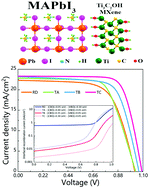Understanding the pathways toward improved efficiency in MXene-assisted perovskite solar cells
Abstract
A large and rapidly expanding class of two-dimensional (2D) metal carbides, nitrides, and carbonitrides called MXenes, with their interesting photovoltaic applications and tunable surface termination, has found a vast range of applications in improving the performance of perovskite solar cells (PSCs). By doing simulations, we report the influence of adding Ti3C2Tx MXene into the absorber layer, and at the interfaces in a PSC, to achieve physical understanding about its impact on the improvement of the performance of the PSC. In this work, the considered architecture contains the methylammonium lead triiodide (MAPbI3) absorber layer, TiO2 electron transport layer, and Spiro-OMeTAD hole transport layer. The simulations show that the addition of Ti3C2Tx to the halide perovskite and TiO2 layers induces an electric dipole at the interfaces that can change the band alignment between the charge transfer layers and absorber layer. The combined action of the work function tuning and interface engineering can modify the electric field distribution in the layers, which can increase the built-in potential, affect the photocurrent and current density, and finally improve the performance of MXene-modified PSCs with respect to reference cells without MXene. This work provides a theoretical discussion to display the promising role of MXenes to be used in PSCs to improve their performances.



 Please wait while we load your content...
Please wait while we load your content...